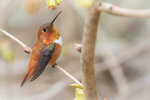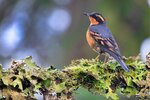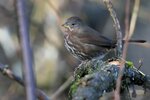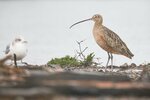



I’ve written about bird migration before, and I’ll do it again. It’s a wonderfully complex phenomenon.
It’s been more than a month since spring’s dawn chorus quieted. The birds’ eggs have hatched, and most of the young have fledged and are on their own. The season has changed from breeding and parenting to migration.
Some of our Thurston County birds spend their whole lives right here, but most migrate to other places as part of their annual cycle. This includes birds eager to breed that arrive here to take advantage of summer’s food abundance, primarily insects (birds like the swallows and flycatchers) and birds that breed elsewhere and spend the winter here (ducks and geese, for example).
Bird migration has puzzled humans for thousands of years. Where do they go and how do they manage to come back to the same area? Some birds confused people by changing the colors of their feathers from one season to another. That may be why the Greek philosopher Aristotle thought it possible that birds changed from one species to another from summer to winter. They also speculated that birds hibernated, and that’s why they weren’t seen in one season or another.
The many migration puzzles have been studied by ornithologists and other researchers over generations. While we still don’t have all the answers, we do know more about bird migration than the ancient Greeks.
Migration’s primary driving force is food. Ponds in northern Canada make good breeding areas for grebes and loons, but winter food is much more available in the open waters of Puget Sound. Migration is difficult and risky, and not all birds survive. But for migratory birds, there is no other option than to fly long distances – in some cases thousands of miles in all kinds of weather – to find a dependable food supply.
In recent times, migrating birds have navigated new dangers. Humans have constructed tall buildings, communication towers and windmills along their migration corridors. Birds are sometimes attracted to the lights of these structures, and collisions take the lives of many migrating birds. This impact of “light pollution” is not as widely recognized or acknowledged as it ought to be.
How do the birds “know” it’s time to move? Studies suggest that the timing of long-distance migration is determined primarily by the changes in day length. However, local migrations may also be driven by changes in temperature and food supply. Examples of the latter are Fox Sparrows and Varied Thrushes. In late Spring, they migrate to higher elevations in the mountains for breeding; however, about the time one realizes they aren’t around, they return from this brief breeding sojourn to spend the fall and winter here, closer to sea level.
Most birds fly north-south in flocks along well-established migration corridors. Currently, you might see small flocks of swallows gathered on utility lines. Soon these small flocks will merge into larger flocks and fly south to the tropical Americas. And, about the same time, large flocks of waterfowl will be arriving in our area for the winter from the north.
But how do they know which direction to go? For a flock, it’s easy to imagine that older birds “know” the direction and pass this information on to the next generation. But not all birds migrate in flocks. Some, for example, our little Rufous Hummingbirds, migrate as individuals.
The answer, in part, is that birds have the ability to detect magnetic fields. Imagine that you could feel magnetic effects (the magnetic pull of north, for example) the same way you can feel hot or cold. Many birds can, and they use this ability, plus the direction of the sun and perhaps other visual cues, to accomplish amazing migration feats.
The Bristle-thighed Curlew is a bird species that breeds in Alaska and migrates south across the open water of the Pacific Ocean to Hawaii and islands further south for the winter, sometimes flying 2500+ miles non-stop. That’s amazing, but more amazing is that the adults depart first, leaving the young to migrate alone! Obviously, there is some remarkable innate mechanism at work here, and we still don’t fully understand it.
This curlew is a close relative of the Long-billed Curlew. Recent reports from the Billy Frank Jr. Nisqually National Wildlife Refuge indicate that one or more of these remarkable birds are still present. They are generally seen along the first 1/3rd of the long boardwalk on the McAllister side of the refuge.
Bird Migration has long been a major subject of ornithology research. Early work was conducted on homing pigeons (which are actually our familiar Rock Doves) and subsequent studies have involved many bird species around the world. The consensus is that birds use a variety of cues, singly or in combination, to navigate migration. These include magnetism, the direction and angle of the sun, the stars and other visual landmarks that are held in a mental map. This suggests that there might be a lot of mystery and subtlety in what people so often disparage as a “bird brain.”
George Walter is environmental program manager at the Nisqually Indian Tribe’s natural resources department; he also has a 40+ year interest in bird watching. He may be reached at george@theJOLTnews.com
Photos for this column are provided by Liam Hutcheson, a 16-year-old Olympia area birder and avid photographer.
Comments
No comments on this item Please log in to comment by clicking here